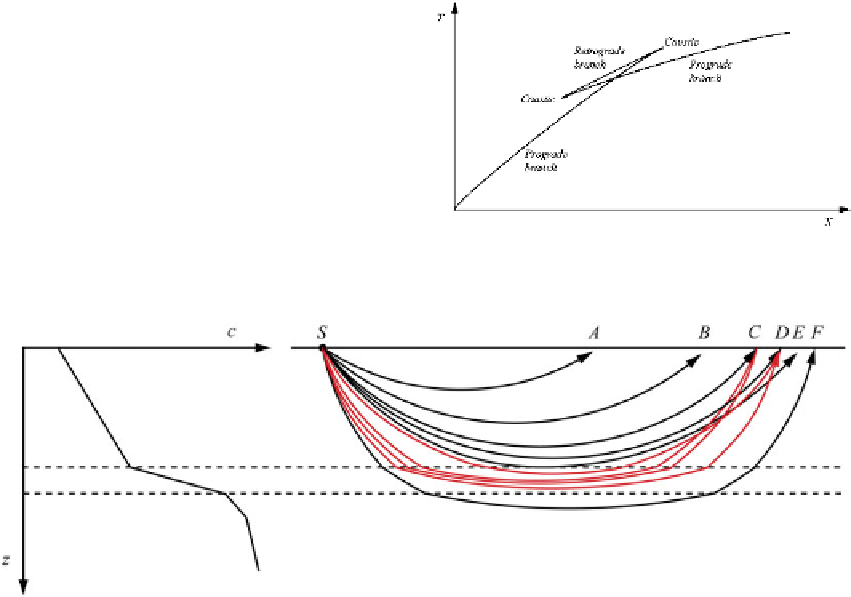Geology Reference
In-Depth Information
it contains a
triplication
(Fig.
9.13
), while the
corresponding cusps at the end points of the
retrograde tract are called
caustics
. Caustics are
hit by two distinct seismic rays, while any other
point in the range of the retrograde branch will
be hit by three rays. At the caustics, we have
that
dX
/
dp
D
0, because these points separate
branches for which
T
increases as the parameter
p
decreases (prograde branches) by tracts such that
the travel time decreases for decreasing values
of
p
(retrograde tract). The triplication range is
always associated with greater energy delivery,
because of ray focusing (see Sect.
9.2
).
In particular, ray theory predicts infinite am-
plitude of the seismic waves at the caustics. To
prove this, let us consider the distribution of seis-
mic energy along a wavefront in the simple case
of a laterally homogeneous model. In Sect.
8.4
we have shown that the average energy density is
proportional to the wave amplitude
A
andtothe
Z
R
rs
2
.r/
p
r
2
s
2
.r/
p
2
dr
T.p/
D
2
(9.64)
r
min
where
r
min
is the distance from the Earth's center
at the turning point.
9.5
Travel Time Curves
We have seen that the range
X
(
p
) is a decreas-
ing function of the ray parameter
p
,asshown
in Fig.
9.10
. Therefore, we expect that in nor-
mal conditions
dX
/
dp
< 0. However, when the
velocity profile includes segments characterized
by elevated gradient, the behaviour of seismic
rays becomes more complicate. In the case of
rays with a turning point below or above the
high-gradient layer, the corresponding tracts of
travel time curve will have a trend similar to that
illustrated in Fig.
9.11
, thereby the arrival time
increases and the parameter decreases for increas-
ing distance from the source. These portions of
travel-time curve are called
prograde
.
When seismic rays bottom in the high velocity
gradient region, the increased bending determines
a decrease of range, as illustrated in Fig.
9.12
.
In this instance, some stations will experience
more than one arrival for the same kind of seismic
wave. The corresponding segment of travel time
curve is called
retrograde
. When a travel time
curve includes a retrograde segment, we say that
Fig. 9.13
A travel-time curve containing a triplication
Fig. 9.12
Normal prograde rays (
black lines
) and retro-
grade rays (
red lines
) associated with high velocity gradi-
ent. Seismic rays arriving at stations
A
-
F
have decreasing
take-off angles, but rays that bottom in the high-gradient
layer will have a shorter range. A single ray incides on
A
,
B
,
E
,and
F
, while three distinct rays incide on
C
and
D




